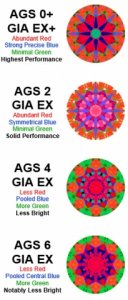i have read some posts on ideal proportions of diamonds and light properties, as well as on testing diamonds with HCA (to weed out) and idealscope.
my question is: suppose you have two GIA XXX diamonds next to each, one is very good in HCA/idealscope, the other one not so much. suppose all other properties are the same (say F colour, VS2 clarity, 1 carat size, to be concrete).
is the difference between these two obvious to the (average) naked eye? will the better one sparkle more? a lot more?
i'm just trying to get a sense of how important the HCA/idealscope results really are in practice (for someone interested in buying a ring).
thanks!
my question is: suppose you have two GIA XXX diamonds next to each, one is very good in HCA/idealscope, the other one not so much. suppose all other properties are the same (say F colour, VS2 clarity, 1 carat size, to be concrete).
is the difference between these two obvious to the (average) naked eye? will the better one sparkle more? a lot more?
i'm just trying to get a sense of how important the HCA/idealscope results really are in practice (for someone interested in buying a ring).
thanks!








300x240.png)